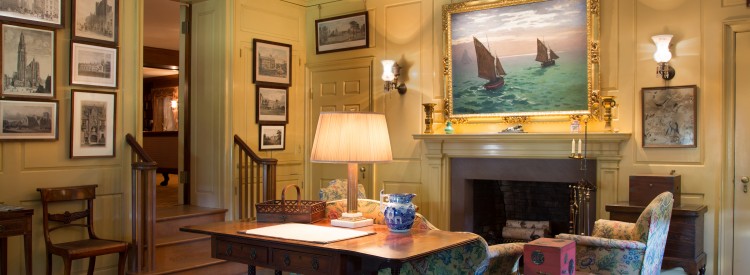Overview
Transport your students to an era of horse and carriages, butlers and maids, and the Impressionists!
Engage in the exploration of history, art and architecture as you tour the 1901 Colonial Revival home of the Pope Riddle family. Learn about the Pope Riddle family and hear the stories of their late-1880’s Grand Tour of Europe. Discover the family’s collection of art treasures including the works by Impressionist painters such as Claude Monet, Edgar Degas, Mary Cassatt; the works of American artist James McNeill Whistler; the bronze sculptures of Antoine-Louis Barye; and the many decorative arts that embellish Hill-Stead’s interior. Walk the halls of one of Theodate Pope Riddle’s greatest accomplishments as one of America’s first female architects.
Learning Objectives
Students will participate in an engaging, interactive museum visit that explores the history, art and architecture of the setting. Tours are conducted in an age-appropriate fashion that will enhance visual literacy through the examination of stimulating works of art.
- History: Students explore a historic home that connects them to the past while understanding its relevance today. The Industrial Revolution was a time of great socioeconomic change that influenced the Popes as well. Mr. Pope worked his success in the expansion of the railroad system. Hill-Stead is a museum that serves as a touchstone to the heritage of the agricultural past while graciously incorporating modern conveniences of post-industrial technologies.
- Art: Students observe an internationally-renowned collection and explore how it tells stories and communicates ideas that are relevant to the historical context as well as to contemporary issues. Students will understand the need for preservation of the cultural treasures from our past as they gain an appreciation for seeing authentic objects in a historical domestic context.
- Architecture: Students will recognize museum founder, Theodate Pope Riddle, as an independent woman, and as the noteworthy female architect who designed Hill-Stead as well as numerous other distinguished structures.
Collection Connections
Paintings
James McNeill Whistler
- Symphony in Violet and Blue, 1893
- Blue Wave—Biarritz, 1862
Edgar Degas
- Jockeys, 1886
- The Tub, 1886
- Dancers in Pink, 1876
Claude Monet
- View of Cap d’Antibes, 1889
- Grainstacks, White Frost Effect, 1888
- Fishing Boats at Sea, 1867 – 1869
Edouard Manet
- Toreadors, 1863
- The Guitar Player, 1866
Mary Cassatt
- Sarah Handing a Toy to the Baby, 1901
- Gathering Fruit, 1893
For more information on individual artists and paintings, follow these links to the Our Collection section of our website.
Other works in the collection
Objects from the collection
- Photographs of Theodate Pope Riddle, John W. Riddle and a photograph of Mary Cassatt taken by Theodate Pope Riddle
- Archival documents
- Book collection
- Dining table and setting
- Vintage garments and personal items
- Stairway print collection
- Special exhibitions (if applicable)
Vocabulary
For a printable vocabulary list, see Vocabulary for HIll-Stead Highlights.
Architecture: The profession of designing buildings, open areas, communities, and other artificial constructions and environments, usually with some regard to aesthetic effect.
Architect: A woman or a man who designs buildings, open areas, communities, and other artificial constructions and environments, usually with some regard to aesthetic effect.
Ceramics: The art or technology of making objects of clay and similar materials treated by firing.
Colonial Revival: A cultural movement popular in the United States during the late nineteenth and early twentieth century that grew as a reaction to the rapid urbanization of the Industrial Revolution. Proponents venerated the American past and held an idealized vision its simplicity, preserving the spirit of earlier times by incorporating what they believed to be traditional values and aesthetics into architecture, decorating styles, literature and even politics. Theodate Pope Riddle was strongly influenced by the Colonial Revival when she designed Hill-Stead.
Gilded Age: A period in U.S. history, between the 1870 and 1900, which was marked by major growth in population and extravagant displays of wealth. The wealth polarization derived from industrial and population expansion.
Grand Tour: An extended tour of continental Europe formerly considered a finishing course in the education of young men of the English upper class.
Impressionism: A style of art developed in France around 1870, generally devoted to subjects of leisure, the upper-middle class and the city, rendered in a naturalist manner often painted directly before nature, or en plein air. The Impressionist style is known for its short, broad sketch-like brushwork, simplified forms and lack of traditional finish. It leaves the viewer with an “impression” of a scene rather than an immensity of detail
Impressionist: A man or a woman during the late nineteenth century who painted in the style of Impressionism.
Industrial Revolution: The totality of the changes in the economic and social organization that began about 1760 in England and spread to other countries. This period is characterized by a rapid growth of industry, the replacement of hand tools with power-driven machines such as the power loom and the steam engine.
Patron: One that supports, protects, or champions someone or something, such as an institution, event, or cause; a sponsor or benefactor.
Portrait: A painting, drawing, photograph of a person.
Preservation: The activity of protecting something, such as an art collection, from loss or danger.
Print: A design or picture transferred to paper from an engraved plate, wood block, lithographic stone, or other media.
Sculpture: The art or practice of shaping figures or designs in the round or in relief, as by chiseling marble, modeling clay, or casting in metal.
Servant: A person who is hired to do household duties, such as cleaning or cooking.su
Spiritualism: The belief that the dead can interact with the living.
Suffragette: A woman who worked to get voting rights for women during the period when women were not allowed to vote.
